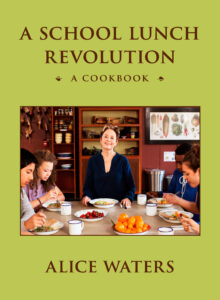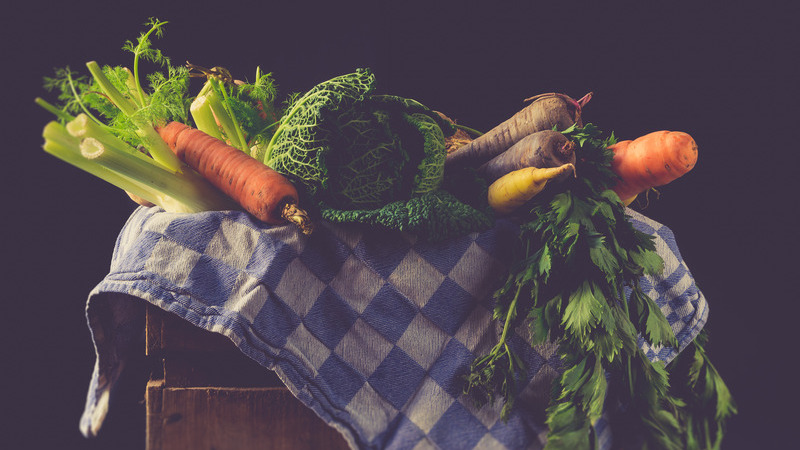I have been running Chez Panisse for fifty‑four years now. I started the restaurant in 1971 after living in France for a year and training in London to be a Montessori teacher. I was looking for the kind of flavor and beauty of food I had experienced in France in the 1960s. The fruits and vegetables I had seen in the French markets were fresh, alive, vibrant, delicious—and that was what I wanted everyone to experience when they came to Chez Panisse.
My pursuit of taste brought me to the doorsteps of local organic farmers and producers. These small California farmers operated entirely differently than the industrial farms in the United States, which prioritized transportability and profits over flavor and health. The organic farmers grew flavorful heirloom varieties of vegetables, or raised heritage breeds; they harvested their crops at peak ripeness. And you could taste the difference.
The most important decision we made at Chez Panisse was to buy only local and seasonal foods. When we did that, it created new inspiration and challenges for the chefs; it opened up a world of winter vegetables we’d never considered. Suddenly we were making celery root soup in the winter, seeing a whole rainbow of carrots we never knew existed. It made us wait in anticipation for the ripe tomatoes in July. And when they were over, they were over, and we moved on to the next harvest.
Eating in season is a deep and inspiring worldview that connects you to nature, to the bounty of the land around you, to the rhythm of your own life. And it is exciting for students, too—they aren’t participating in the tedious, flavorless routine of eating the same second‑rate, out‑of‑season fruits and vegetables all year long. When you cook seasonally, you experience the inspiration that comes from constantly changing ingredients, not from unlimited availability. Students learn to look forward to the moment when strawberries are at their sweetest, or the time in late spring when snap peas finally arrive at the table.
Eating in season is a deep and inspiring worldview that connects you to nature, to the bounty of the land around you, to the rhythm of your own life.
This is the true definition of farm to table, a procurement model that puts the farmer first: we commit to buying whatever our producers tell us is ripe and ready and delicious at that moment—and make our meals accordingly. Of course, this means we have to cook differently throughout the year, and there are times of the year when certain foods aren’t available.
As recently as 1950, Americans mostly ate food that was in season and locally produced, except for maybe imported coffee, tea, and spices. I grew up in New Jersey, where the families I knew would can and preserve fruits and vegetables for the winter, store food, and use greenhouses to grow food through harsher seasons. Cooking in this way is not only what is right for the planet, it is deeply pleasurable—because you cannot have truly delicious food unless it is picked when it’s ripe and eaten soon after.
I can say all of this with conviction because I have seen that it is possible to create a program that rethinks food, seasonality, and education from the ground up. In the Edible Schoolyard Project garden and kitchen classrooms, we use a hands‑on approach to teach academic subjects to a thousand teenage students, a population of children who speak twenty‑two different languages at home. That one school has inspired a network of more than 6,200 like‑minded programs around the world.
I have watched the transformations in these programs. I have seen how students are empowered when they learn about the world through food, and how it changes their relationship to the environment and the food they eat. At the Edible Schoolyard Project, we are teaching middle school students, young teenagers at a tricky transitional time; you might not think of them as the most persuadable audience. And yet they fall in love with real food when they are the ones planting it, growing it themselves, watching it ripen, learning when to harvest and how to cook it. We always like to say that it’s only six weeks to kale: that’s how long it takes for students new to the program to start eating—and loving!—kale.
But more than simply learning to love fruits and vegetables, students are learning about their place in the natural world. When schools are working in partnership with regenerative farmers and producers, serving food to students that is ripe and delicious, it activates students in the way they yearn for—giving them an instant connection to the seasons, an understanding of our ever‑changing climate, and a respect for the land and the people who grew their food.
*
Chicken Noodle Soup
Makes 2 ½ quarts
1 half chicken, or 1 leg and 1 breast on the bone
2 quarts water or chicken broth
1 medium onion, peeled and sliced, plus ½ cup diced
1 carrot, peeled and sliced, plus ½ cup diced
1 celery stalk, trimmed and sliced, plus ½ cup diced
1 large thyme sprig
2 or 3 parsley sprigs Kosher salt
2 ounces fettuccine, broken or cut into bite-size pieces
¼ cup diced parsnip (optional)
2 teaspoons chopped fresh dill
Combine the chicken and water in a large pot. Bring to a boil and then turn down to a simmer. Skim any foam from the top of the liquid. Add the sliced onion, carrot, and celery, and the thyme and parsley sprigs. Cook at a gentle simmer for 40 minutes. Turn the burner off, carefully lift the chicken out of the broth, and let cool. Strain the broth through a fine‑mesh strainer, discard the vegetables, and skim off the fat. Season generously with salt to taste, enough to bring out the full flavor of the chicken.
When the chicken is cool, remove the skin and any bones and shred the meat into bite‑size pieces. Put the meat in a bowl and cover with a spoonful or two of broth to keep it from drying.
Meanwhile, bring a pot of salted water to a rapid boil. Cook the pasta until tender, then drain in a colander and rinse in cold water.
Put the diced onion, carrot, celery, and parsnip (if using) in a heavy stockpot. Cover with 4 cups of the chicken broth and cook at a gentle simmer until tender, about 15 minutes. Once the vegetables have finished cooking, add the remaining broth, the cooked noodles, and the shredded chicken. Bring to a simmer, taste, and adjust the salt as needed. Just before serving, stir in the chopped dill.
Variations:
Garnish with fresh parsley, cilantro, or other tender herbs in place of the dill.
Add other diced vegetables, such as leeks, potatoes, squash, celery root, turnips, and rutabagas.
Substitute fresh noodles for dried fettuccine, or use other shapes of dried pasta.
Substitute cooked brown rice for the noodles.
__________________________________

From A School Lunch Revolution by Alice Waters. Copyright © 2025 by Alice Waters. Published by Penguin Press, an imprint of Penguin Publishing Group, a division of Penguin Random House LLC.







